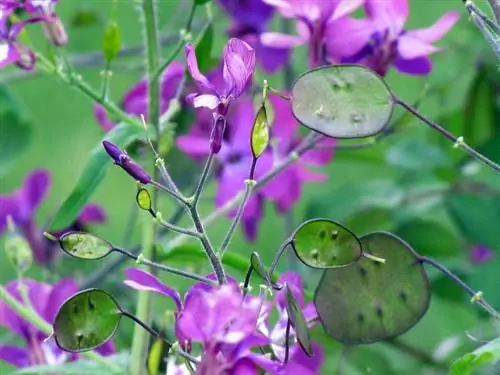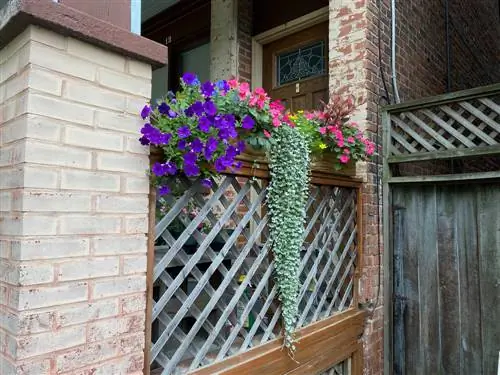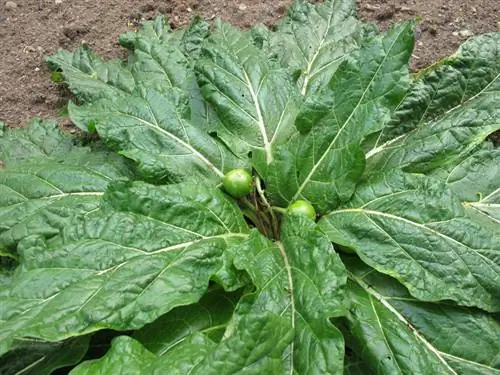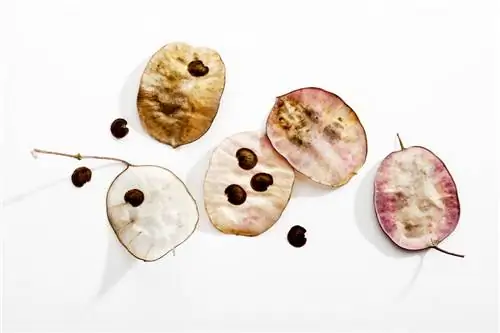- Author admin [email protected].
- Public 2023-12-25 17:45.
- Last modified 2025-01-23 11:20.
The white and purple umbrella panicle flowers are pretty to look at and pamper us with a seductive scent. Of course, the silver leaf makes us wait until autumn for its astonishing feat. Then the pods unfold into silvery, shimmering, delicate leaves that add floral magic to every dry bouquet. The following answers to frequently asked questions reveal how to properly plant and care for the two-year-old or perennial Lunaria.
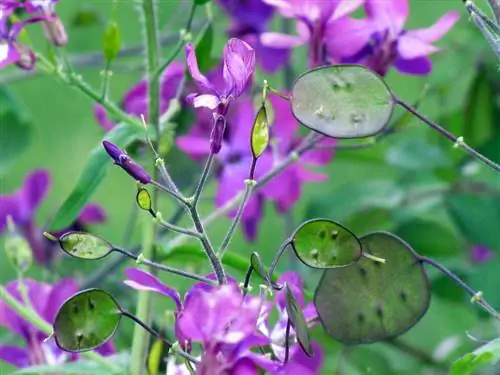
How do I care for a silver leaf in the garden?
The silver leaf (Lunaria) is an attractive plant that thrives in partial shade to shade. For proper care, you should water it regularly without causing waterlogging and fertilize it every 2-3 weeks from April to August. The silvery pods develop in autumn and are ideal for dry bouquets.
Planting silver leaf correctly
You only plant a garden silver leaf that has been grown behind glass in the bed when there is no longer any risk of ground frost. Ideally, the plant was able to harden off on the partially shaded balcony during the day in the previous 2-3 weeks and spend the night on the windowsill. Enrich the soil with compost and horn shavings before placing the Judas silverling in the ground, maintaining the previous planting depth. Then water generously and mulch with leaves.
Care tips
There are no gardening stumbling blocks hidden in the uncomplicated care program. It's that easy:
- Water silver leaf regularly and extensively without causing waterlogging
- From April to August, fertilize every 2-3 weeks with compost (€12.00 on Amazon), horn shavings or liquid fertilizer
- Cleaning out the withered flowers prevents the decorative silver coins in autumn
The rhizome completely absorbs the green parts of the plant during the winter. Cut these off close to the ground in early spring so that the fresh shoots can sprout unhindered.read more
Which location is suitable?
The silver leaf feels at home in semi-shady to shady locations, preferably under the protection of deciduous trees. The magical Lunaria prefers nutrient-rich, fresh to moist soil, because in the wild the plant thrives in ravines near streams, rivers and waterfalls.
What soil does the plant need?
The silver leaf likes to extend its roots in common garden soil. The rustic flower proves to be tolerant of poor soil. In nutrient-rich, fresh, moist and humus-rich soil, the cruciferous plant finds the ideal conditions for a lush abundance of flowers, which results in the hoped-for parchment-soft, silvery pod leaves.
When is flowering time?
Look forward to a long-lasting flowering period from April to July. Of course, this is only considered the floral start-up time for the eye-catching spectacle that the flower creates with its seed heads. Therefore, do not cut off the withered flowers, otherwise you will deprive yourself of the decorative silver thalers in autumn.
Cut silver leaf correctly
In autumn, the above-ground parts of the plant die off completely. The finger-shaped tubers overwinter in the ground, from which both the biennial and the perennial Lunaria sprout in spring. Pruning is therefore only necessary if the dead shoots and leaves impair the appearance of the garden. The extent to which you cut off the withered flowers during the year is your individual decision. With each withered flower, remove the pods, which will develop into decorative silver thalers over the course of the autumn.read more
Water silver leaf
The silver leaf is a thirsty fellow that cannot tolerate drought. Therefore, water regularly and extensively without causing waterlogging. The sunnier the location, the more often the watering can is used. In the pot, this may be necessary every day on warm summer days.
Fertilize silver leaf properly
With regular fertilizer applications, you can prepare the garden silver leaf for a rich display of decorative autumn decorations. From April to August, work a portion of compost with horn shavings into the soil every 3 weeks and water again. Alternatively, apply a nitrogen-rich slow-release fertilizer in April and June. In pot cultivation, we recommend applying liquid fertilizer for 14 days.
Wintering
The silver leaf is completely hardy. There is no need to take any precautions in the bed, as the above-ground parts of the plant die and only the root ball overwinters in the ground. In the pot, on the other hand, there is a risk that the roots will freeze due to the exposed position behind the thin vessel walls. Therefore, wrap the pot or flower box with jute ribbons, fleece or bubble wrap and slide a wooden block underneath.
Propagate silver leaf
The silver leaf can be easily propagated by sowing. Since these are cold germinators, sow the seeds directly into the bed in August/September in a partially shaded to shady location. How to do it right:
- Create a fine, crumbly seedbed, free of weeds, roots and stones
- Place the seeds 1-2 cm deep into the soil at a distance of 20-30 cm and sieve thinly with sand
- Wet the bed with a fine spray and cover it with a close-meshed protective net
You can alternatively propagate a perennial silverleaf species, such as Lunaria rediviva, by division. To do this, dig up the rhizome in autumn or spring to cut off 5 cm long pieces of roots. You can plant these directly in the ground at the new location or initially grow them in the pot.read more
Is silver leaf poisonous?
Just a look at the botanical classification gives the all-clear regarding possible toxic content. As a cruciferous vegetable, silver leaf is related to crops such as Brussels sprouts, cauliflower, rapeseed or cress. There is no trace of toxic ingredients anywhere. Therefore, the whole family can enjoy the decorative attributes of the silver thaler.read more
Silverleaf doesn't bloom
If a silver leaf refuses to bloom, the first step is to check the site conditions. If everything is within limits, question the care. In order to get to the bottom of the cause, we have put together all the common triggers for you here with tips on how to fix them:
- Too sunny: The silver leaf thrives in a partially shaded to shady location.
- Soil that is too dry: Allocate a place for a Lunaria in fresh, moist, nutrient-rich soil.
- Drought stress: Water the plant as soon as the substrate has dried.
- Nutrient deficiency: From May to August the silver thaler depends on a regular supply of nutrients.
If it is a seedling-propagated plant, a little patience is required. Both the annual and the perennial species only bloom in the bed from the second year onwards.
Beautiful varieties
- Judaspfennig: Two-year-old silver leaf that remains true to its place in the bed over the years when sown
- Moon violet: Pretty silver-leaf perennial with white, purple-tinged flowers and the unmistakable seed heads
- Albiflora: Award-winning variety that stands out with countless creamy white panicles
- Moneta del Papa: Rustic, richly branched summer flower with purple flowers and parchment thalers in autumn

